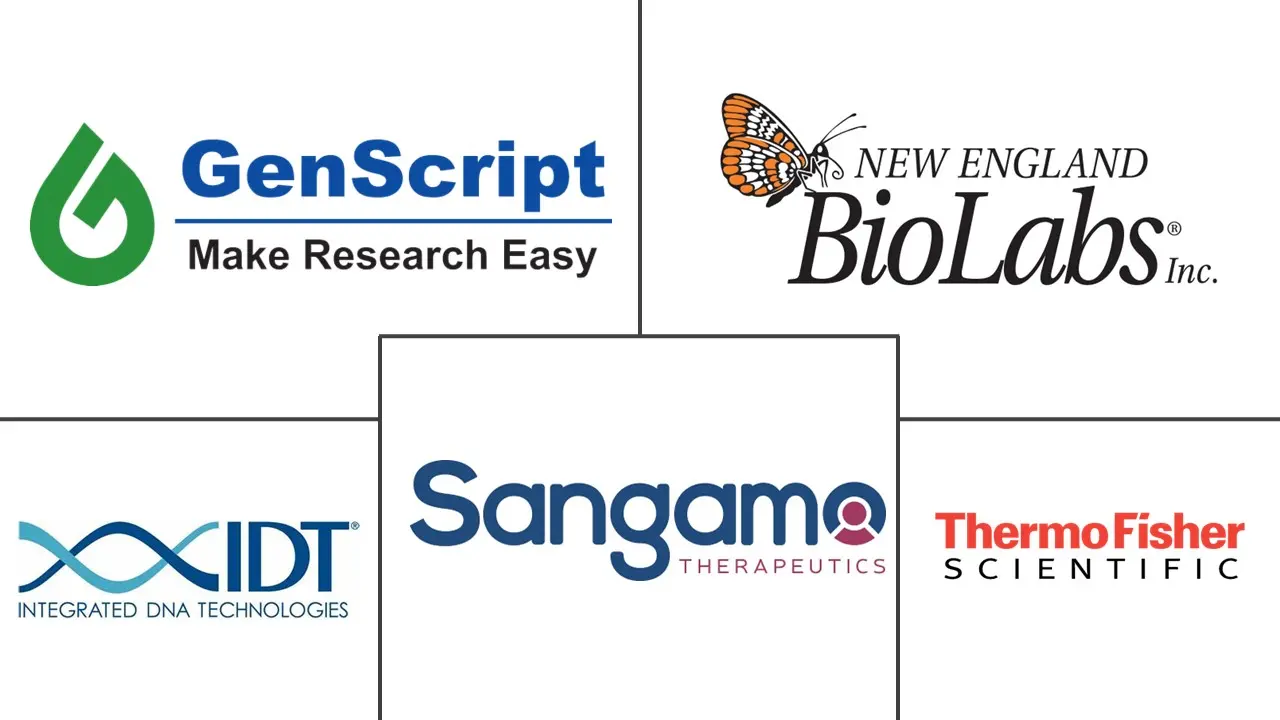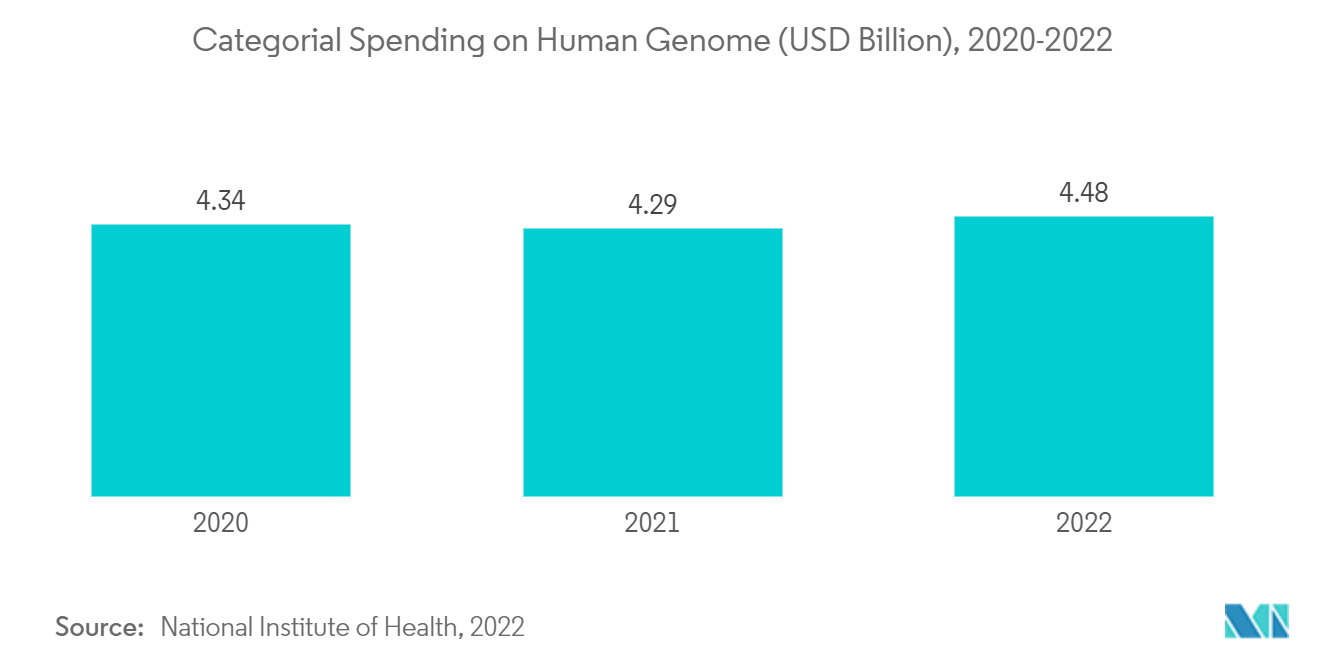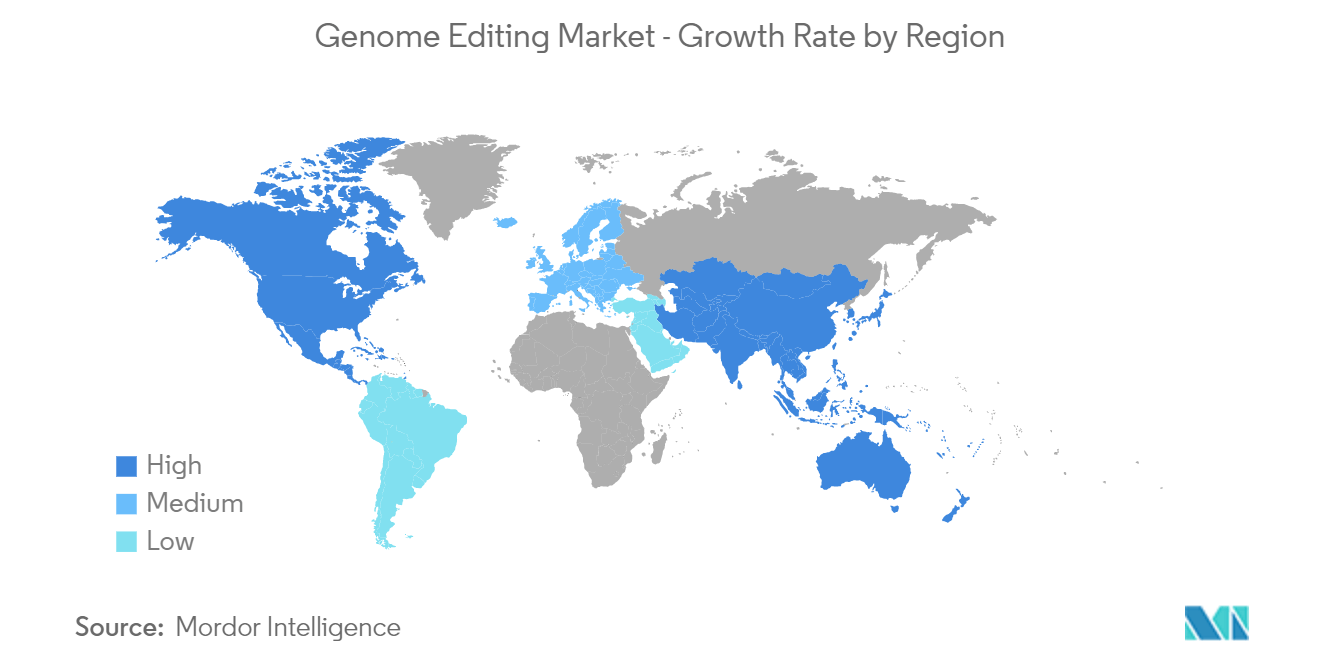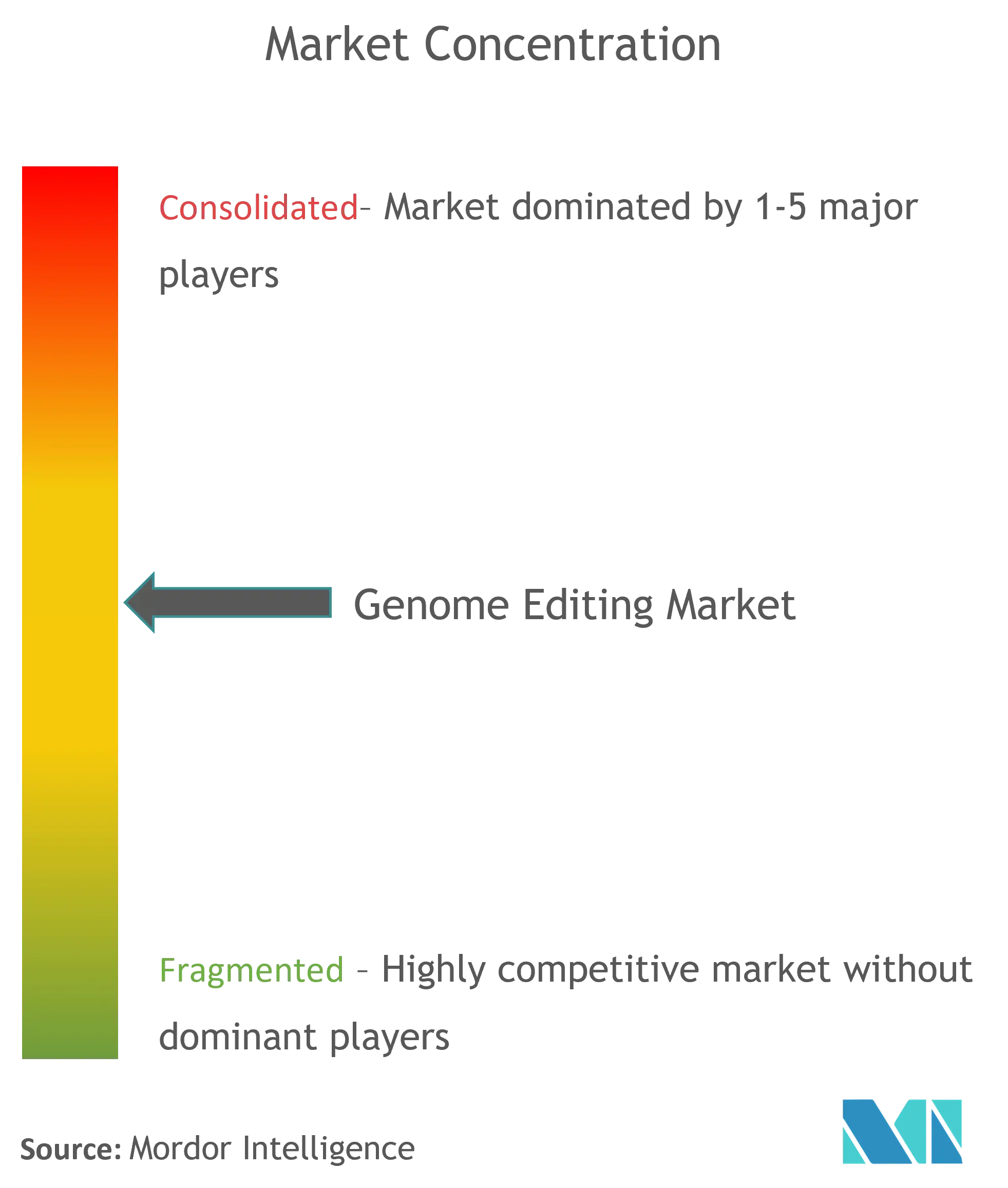Genome Editing Market Size

| Study Period | 2019 - 2029 |
| Base Year For Estimation | 2023 |
| CAGR | 14.40 % |
| Fastest Growing Market | Asia Pacific |
| Largest Market | North America |
| Market Concentration | Medium |
Major Players
*Disclaimer: Major Players sorted in no particular order |
Genome Editing Market Analysis
Genome Editing Market is expected to register a healthy CAGR of nearly 14.4% during the forecast period, 2022-2027.
Molecular biology tools that include gene editing approaches, such as CRISPR-Cas12/13-based SHERLOCK, DETECTR, CARVER and PAC-MAN, ASO, antisense peptide nucleic acids, ribozymes, aptamers, and RNAi silencing therapies, proved to be crucial in COVID-19 outbreaks when compared to conventional diagnostic or treatment methods. For instance, in February 2022 a review article published titled "A Review of COVID-19: Treatment Strategies and CRISPR/Cas9 Gene Editing Technology Approaches to the Coronavirus Disease" stated that for detecting a wide range of target genes, the CRISPR/Cas categories provide highly sensitive and selective tools. Genome-wide association studies are a relatively new strategy for discovering genes involved in human disease when it comes to the next steps in genomic research. Thus, COVID-19 had impacted the growth of the genome editing market over the forecast period.
The increasing prevalence of cancer and other genetic disorders, growing preference for personalized medicine, increase in private and public sector funding, and rapid advancements in sequencing and genome editing technologies are some of the factors propelling the growth of the genome editing market. According to the National Center for Advancing Translational Sciences updates form June 2022, the Somatic Cell Genome Editing (SCGE) Program at the National Institutes of Health (NIH) has awarded 24 more grants to researchers across the United States and Canada. The SCGE Program has awarded a total of USD 89 million in advance genome editing grants, over the next four years. This brings the total number of projects supported to 45, with approximately USD 190 million in funding spread out over six years. Such grants from the national institutes help to boost the market over the forecast period. Additionally, in May 2020, Rice University researchers have been awarded a four-year, USD 2.45 million grant from the National Institutes of Health (NIH) to support the development of a gene-editing treatment for sickle cell disease (SCD). The R01 grant, funded by the National Institutes of Health, aims to advance a method of modifying the stem cells responsible for producing damaged blood cells in SCD patients. The increase in research grants is expected to surge the research studies for genome editing which is expected to boost the growth of the studied market over the forecast period.
Moreover, in January 2020, Garner was allocated the National Institutes of Health (NIH) grant of more than USD 6 million to the fight against genetic diseases. Increasing research in the feild of genome editing is another factor propelling the growth of the market. According to the article published in the Frontier in Genome Edition in March 2021, titled 'CRISPR/Cas: Advances, Limitations, and Applications for Precision Cancer Research' CRISPR/Cas is a technology capable of making specific genome modifications in living eukaryotic cells. Sequence deletions, insertions, substitutions, integrations, and epigenetic gene regulation are all examples of genomic modifications.
Collaborations are another factor in the growth of the market. For instance, in November 2020, Eli Lilly partnered with Precision BioSciences to use the ARCUS platform to research and develop potential in vivo therapies for genetic disorders, through a collaboration that could potentially generate about USD 2.7 billion for the Durham, NC, developer of therapies based on genome editing as well as 'off-the-shelf' CAR T immunotherapies. Hence, such collaborations would increase market growth in the upcoming future.
However, the high cost of genomic equipment and ethical concerns related to genetic research will hinder the market growth.
Genome Editing Market Trends
This section covers the major market trends shaping the Genome Editing Market according to our research experts:
Clustered Regularly Interspaced Short Palindromic Repeats (CRISPR) is Expected to Hold a Significant Market Share Over the Forecast Period
The rise in funding and initiatives by the government to develop vaccines, medical technologies, drugs, and devices are further propelling the growth of the genome editing market globally. Additionally, the research studies conducted for CRISPER technology are another factor for the market's growth. According to the study titled 'CRISPR-Cas9 Gene Editing for Sickle Cell Disease and β-Thalassemia' published in the New England Journal of Medicine in January 2021, CRISPR-Cas9-based gene editing is being tested to treat two cases of inherited diseases: one in a patient with TDT (β-Thalassemia) and the other in a patient with SCD (Sickle Cell Disease). During the 12 months following the administration of CTX001, both patients experienced early, substantial, and sustained increases in fetal hemoglobin levels with more than 99% pancellularity. Thus, the application of CRISPR technology in Sickle Cell Disease and β-Thalassemia is expected to rise its demand over the forecast period.
Product launch is another factor in the market growth. In September 2020, The Tata CRISPR (Clustered Regularly Interspaced Short Palindromic Repeats) FELUDA test, powered by CSIR-IGIB (Institute of Genomics and Integrative Biology), FELUDA test, received regulatory approvals from the Drug Controller General of India (DCGI) for commercial launch, as per ICMR guidelines, test meeting high-quality benchmarks with 96% sensitivity and 98% specificity for detecting the novel coronavirus. This test uses an indigenously developed, cutting-edge CRISPR technology for the detection of the genomic sequence of the SARS-CoV-2 virus. CRISPR is a genome-editing technology for diagnosing diseases. Additionally, in December 2021, Thermo Fisher Scientific recently introduced its new protein, Invitrogen TrueCut HiFi Cas9 Protein, to complement its growing CRISPR gene editing solutions portfolio.
Thus, owing to the abovementioned factors are expected to drive the CRISPR technology market over the forecast period.

North America is Expected to Dominate the Market Over the Forecast Period
The Genome Editing market is dominated by North America due to the strong growth trend in the pharmaceuticals and biotechnology industries. Factors such as technological innovation in genome editing technology, increasing product approvals, and rising research and development procedures are expected to increase the market growth during the study period.
In March 2021, scientists at the University of California (UC), San Francisco, UC Berkeley, and UC Los Angeles have received the United States Food and Drug Administration approval to jointly launch an early phase, first-in-human clinical trial of a gene correction therapy in patients with sickle cell disease using the patient's blood-forming stem cells.
Similarly, in October 2020, Merck signed a licensing agreement with Takara Bio USA, Inc. Through this agreement Merck has licensed its CRISPR technology to Takara to develop vectors and other innovative products to support research using CRISPR as well as cell engineering services, particularly stem cells.
Additionally, in March 2021, Health Canada proposed new guidelines for the Novel Food Regulations, specifically focused on plant breeding stating that gene-editing technology in agriculture is just as safe as conventional plant breeding. These guidelines provide more certainty for plant breeders and crop science companies. Such steps by the government are expected to expand the applications of CRISPR thus, boosting the studied market.
Additionally, in April 2022, a research study published titled "Transcription activator-like effector nuclease (TALEN) as a promising diagnostic approach for COVID-19" stated that TALEN has many advantages, such as unlimited target sites and high specificity. Compared to other methods, it has shown promising results and potential and serves as an essential genome editing tool for diagnostic work-up and treatment issues in infectious diseases. The characteristics defined for this technique are promising, i.e. potential for rapid, on-site, and non-expensive diagnostic work-up, especially during pandemics. Hence, such studies would increase the market growth in the region.
Thus, the abovementioned factors are likely to increase market growth in the upcoming future.

Genome Editing Industry Overview
The market is partially fragmented and consists of several major players. Most of the players are based in developing counties due to more technological advancements. But due to the ease of connectivity in modern times, these players have also penetrated developing countries and are trying to establish a market in these countries as well. High growth potential in emerging regions provides new opportunities to industry players. Some of the companies which are currently dominating the market are GenScript USA Inc., Integrated DNA Technologies Inc., New England Biolabs Inc., Sangamo Biosciences Inc., and Thermo Fisher Scientific Inc. among others.
Genome Editing Market Leaders
-
GenScript USA Inc.
-
Integrated DNA Technologies Inc.
-
New England Biolabs Inc.
-
Sangamo Biosciences Inc.
-
Thermo Fisher Scientific Inc.
-
Genscript Biotech Corp
*Disclaimer: Major Players sorted in no particular order

Genome Editing Market News
- In February 2022, Integrated DNA Technologies unveiled Alt-R HDR Donor Blocks, an improved solution for increasing homology-directed repair (HDR) rates. Alt-R HDR Donor Blocks are the latest addition to IDT's complete portfolio of Alt-R CRISPR genome editing solutions.
- In February 2022, Intellia Therapeutics, Inc. and Regeneron Pharmaceuticals, Inc. announced the positive interim data from an ongoing Phase I clinical study of their lead in vivo genome editing candidate, NTLA-2001 (Investigational Crispr Therapy For Transthyretin (Attr) Amyloidosis).
Genome Editing Market Report - Table of Contents
1. INTRODUCTION
- 1.1 Study Assumptions and Market Definition
- 1.2 Scope of the Study
2. RESEARCH METHODOLOGY
3. EXECUTIVE SUMMARY
4. MARKET DYNAMICS
- 4.1 Market Overview
-
4.2 Market Drivers
- 4.2.1 Rising Incidence of Chronic Diseases
- 4.2.2 Rise in Production of Genetically Modified Crops
- 4.2.3 Increasing Government Funding and Growth in the Number of Genomics Projects
-
4.3 Market Restraints
- 4.3.1 High Cost of Genomic Equipment
- 4.3.2 Ethical Concerns Related to Genetic Research
-
4.4 Porter's Five Forces Analysis
- 4.4.1 Threat of New Entrants
- 4.4.2 Bargaining Power of Buyers/Consumers
- 4.4.3 Bargaining Power of Suppliers
- 4.4.4 Threat of Substitute Products
- 4.4.5 Intensity of Competitive Rivalry
5. MARKET SEGMENTATION (Market Size by Value - USD million)
-
5.1 By Technology
- 5.1.1 Clustered regularly interspaced short palindromic repeats (CRISPR)
- 5.1.2 Transcription activator-like effector nuclease (TALEN)
- 5.1.3 Zinc Finger Nuclease (ZFN)
- 5.1.4 Other Technologies
-
5.2 By Application
- 5.2.1 Cell Line Editing
- 5.2.2 Animal Genome Editing
- 5.2.3 Plant Genome Editing
- 5.2.4 Others
-
5.3 By End user
- 5.3.1 Pharmaceutical companies and Biotechnology Companies
- 5.3.2 Academics and Government Research Institutes
- 5.3.3 Clinical Research Organizations
-
5.4 Geography
- 5.4.1 North America
- 5.4.1.1 United States
- 5.4.1.2 Canada
- 5.4.1.3 Mexico
- 5.4.2 Europe
- 5.4.2.1 Germany
- 5.4.2.2 United Kingdom
- 5.4.2.3 France
- 5.4.2.4 Italy
- 5.4.2.5 Spain
- 5.4.2.6 Rest of Europe
- 5.4.3 Asia-Pacific
- 5.4.3.1 China
- 5.4.3.2 Japan
- 5.4.3.3 India
- 5.4.3.4 Australia
- 5.4.3.5 South Korea
- 5.4.3.6 Rest of Asia-Pacific
- 5.4.4 Middle-East and Africa
- 5.4.4.1 GCC
- 5.4.4.2 South Africa
- 5.4.4.3 Rest of Middle-East and Africa
- 5.4.5 South America
- 5.4.5.1 Brazil
- 5.4.5.2 Argentina
- 5.4.5.3 Rest of South America
6. COMPETITIVE LANDSCAPE
-
6.1 Company Profiles
- 6.1.1 Editas Medicine
- 6.1.2 GenScript USA Inc.
- 6.1.3 Horizon Discovery Group plc
- 6.1.4 Integrated DNA Technologies Inc.
- 6.1.5 Lonza Group Ltd
- 6.1.6 Merck & Co.
- 6.1.7 New England Biolabs Inc.
- 6.1.8 Origene Technologies Inc.
- 6.1.9 Sangamo Biosciences Inc.
- 6.1.10 Takara Bio Inc.
- 6.1.11 Thermo Fisher Scientific Inc.
- 6.1.12 Transposagen Biopharmaceuticals Inc.
- *List Not Exhaustive
7. MARKET OPPORTUNITIES AND FUTURE TRENDS
** Subject To AvailablityGenome Editing Industry Segmentation
Gene editing or Genome editing is a type of genetic editing where a DNA is inserted, deleted or replaced in the genome of an organism to treat a particular disease using an engineered nuclease or molecular scissors. These nucleases create site-specific double-stranded breaks at desired locations in the genome. The induced double-stranded breaks are repaired through nonhomologous end joining or homologous recombination resulting in targeted mutations (edits). The Genome Editing Market is segmented by Technology (Clustered regularly interspaced short palindromic repeats (CRISPR), Transcription activator-like effector nuclease (TALEN), Zinc Finger Nuclease (ZFN), and Other Technologies), Application (Cell Line Editing, Animal Genome Editing, Plant Genome Editing, and Others), End User (Pharmaceutical companies and Biotechnology Companies, Academics and Government Research Institutes, and Clinical Research Organizations), and Geography (North America, Europe, Asia-Pacific, Middle East and Africa, and South America). The market report also covers the estimated market sizes and trends for 17 different countries across major regions, globally. The report offers the value (in USD million) for the above segments.
| By Technology | Clustered regularly interspaced short palindromic repeats (CRISPR) | |
| Transcription activator-like effector nuclease (TALEN) | ||
| Zinc Finger Nuclease (ZFN) | ||
| Other Technologies | ||
| By Application | Cell Line Editing | |
| Animal Genome Editing | ||
| Plant Genome Editing | ||
| Others | ||
| By End user | Pharmaceutical companies and Biotechnology Companies | |
| Academics and Government Research Institutes | ||
| Clinical Research Organizations | ||
| Geography | North America | United States |
| Canada | ||
| Mexico | ||
| Geography | Europe | Germany |
| United Kingdom | ||
| France | ||
| Italy | ||
| Spain | ||
| Rest of Europe | ||
| Geography | Asia-Pacific | China |
| Japan | ||
| India | ||
| Australia | ||
| South Korea | ||
| Rest of Asia-Pacific | ||
| Geography | Middle-East and Africa | GCC |
| South Africa | ||
| Rest of Middle-East and Africa | ||
| Geography | South America | Brazil |
| Argentina | ||
| Rest of South America |
Genome Editing Market Research FAQs
What is the current Global Genome Editing Market size?
The Global Genome Editing Market is projected to register a CAGR of 14.40% during the forecast period (2024-2029)
Who are the key players in Global Genome Editing Market?
GenScript USA Inc., Integrated DNA Technologies Inc., New England Biolabs Inc., Sangamo Biosciences Inc., Thermo Fisher Scientific Inc. and Genscript Biotech Corp are the major companies operating in the Global Genome Editing Market.
Which is the fastest growing region in Global Genome Editing Market?
Asia Pacific is estimated to grow at the highest CAGR over the forecast period (2024-2029).
Which region has the biggest share in Global Genome Editing Market?
In 2024, the North America accounts for the largest market share in Global Genome Editing Market.
What years does this Global Genome Editing Market cover?
The report covers the Global Genome Editing Market historical market size for years: 2019, 2020, 2021, 2022 and 2023. The report also forecasts the Global Genome Editing Market size for years: 2024, 2025, 2026, 2027, 2028 and 2029.
Genome Editing Industry Report
Statistics for the 2024 Genome Editing market share, size and revenue growth rate, created by Mordor Intelligence™ Industry Reports. Genome Editing analysis includes a market forecast outlook to 2029 and historical overview. Get a sample of this industry analysis as a free report PDF download.



